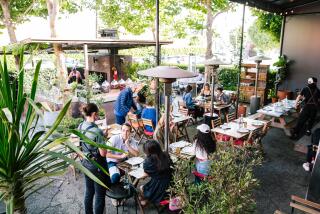Learning the wonders of the sharing economy in trip to Denver

Reporting from Denver, Colo. — Meet my friends Joanna, Jo and Brenton, and Beth. They really helped me out on my recent trip to Denver.
Joanna lent me her car. Jo gave up his room and crashed in Brenton’s room so I would have a place to sleep. Beth invited me for a lovely dinner.
Thing is, I didn’t know any of them before my trip here last month.
These trusting souls are part of the sharing economy, also called collaborative consumption or peer-to-peer sharing, which may be the hottest trend in travel since the birth of frequent-flier programs.
The concept is simple: What isn’t being used can be shared or lent — a spare room, an extra car or even expertise — maybe for a fee, maybe not. (A headline on Time Inc.’s Money blog recently snipped, “Can We Stop Pretending the Sharing Economy Is All About Sharing?”)
You’re probably familiar with some of the players in this sea change. Airbnb, which allows people to rent a room or a whole abode, has grown like a house afire since its founding in 2008. Its revenue for 2012 was estimated at $180 million, according to Forbes, quoting research company PrivCo.
Uber, the ride-sharing service that picks you up at the touch of an app, may be worth as much as $18 billion (or not, says FiveThirtyEightEconomics), but whatever its value, you can bet your next paycheck that it’s more than most of us bring home in a month.
But, sharing proponents say, it’s not about money. It’s about making connections and about finding real people, which is important when you travel. It’s about getting insider information to experience a city more fully. And, most of all, it’s about trust.
I found all of this to be true on my try-it-out-trip to Denver, which I chose because it’s not Seattle, no offense to either. I met the nicest people, ate and slept well, found great office space, took a fun tour and learned a lot about my host city.
And I didn’t get ripped off — or worse — by anyone.
Which may be the most surprising part of this peer-to-peer experience, except that these are not my peers. To a person, my new BFFs are Gen Y, or millennials, those born between 1977 and 1994 or ‘96, depending on whose scale you use. Bottom line: They ain’t afraid of no guests.
When I was making dinner arrangements with Beth Brandstatter through Meal Sharing, I suggested she Google me to make sure I was who I said I was. In an email, she replied, “I like the element of surprise and one of the fun things about meal sharing is this is a trusting community.”
At times, I wanted to say to all of them, “Are you crazy? What is wrong with you people?” But after a couple of days, I discovered too much that was right to burst their shared balloon.
Yes, I’ve read about issues with some of the people and organizations. The San Francisco Chronicle recently reported that some Airbnb hosts are keeping what should be long-term rental properties off the market and using them for short-term. For its part, Airbnb will begin paying taxes while insisting it is not a hotel organization. There have been incidents where hosts’ homes have been damaged and guests have been less than delighted.
But on the whole, this linking of collective arms and singing of “Kumbaya” seems to be working, and it may mean a new chapter on how to have a richer travel experience.
_______
An Airbnb room in Denver that’s clean and, best of all, safe
As I looked at hotel room rates in Denver, I kept repeating to myself, “It’s not about the money.”
Still, it was hard to ignore how much I would save: The best rate I found for my July trip was $175 a night for a room at a Comfort Inn, not including taxes and fees. The rate I would pay for an Airbnb room in a beautiful downtown Denver apartment? $108 a night, with a $13-a-night fee. (You’re welcome, accounting department.)
No-brainer, right?
Except the brain wouldn’t shut up with its nagging questions about cleanliness, awkwardness and rattiness. And, perhaps the most important question: Is it crazy for somebody’s grandma to stay in an apartment with two 24-year-old men?
Yes, it’s crazy. Crazy good. I had a comfortable place to stay, information on the best of Denver (Bruegger’s Bagels for breakfast, the newly remodeled and reopened Union Station) and suggestions for several books that would be fun to read just because they were.
It would be easy to say that it’s obvious why Airbnb has grown so large so fast, but one stay does not an empire make. Eight hundred thousand accommodations in 192 countries do.
Airbnb is the big dog of accommodations in the sharing economy, but it’s not the only one and certainly not the newest one: People have been swapping homes for years through such programs as HomeExchange. There’s also CouchSurfing (let me sleep on your sofa and I’ll let you sleep on mine).
In Colorado, where marijuana is newly legalized, there’s even CannaBeds, which describes itself as the “premiere marketplace for finding and renting cannabis friendly accommodations.”
In fact, travelers now have so much choice that it may be difficult to decide. But in this case, my choice seemed clear: I wanted to be in downtown Denver, and Brenton Weyi and Joseph (who goes by Jo) Chehouri’s apartment met that requirement. I would have a room with a love seat and a desk, great views of downtown and lots of natural light. (I would also have a room with traffic noise at night, for which the hosts thoughtfully supplied earplugs.) It was near public transportation and the buzz of a city that has come into its own.
But there was something else, intangible but important, that came across in their listing: Their place felt safe.
Both smiled when I mentioned that. Trust isn’t something that we baby boomers do easily, which may be the biggest obstacle to our participation in the sharing economy.
Yet who wouldn’t want to stay in a place with free Wi-Fi, where the hosts take the time to tell you about how they grew up, the sons of struggling immigrants, and managed to succeed? Who wouldn’t want to be in a beautiful, historic building? Who wouldn’t want to swap stories over a meal I invited them to just to say thanks?
Maybe not everybody. But I did. And I do. Watch out, fellas. I’ll be back.
_______
RelayRides and Uber may have the keys to getting around
Joanna Parker, a recent transplant to Denver, knows her 2006 Toyota Corolla isn’t well suited to winter forays to the mountains, so she’s saving her money to buy a four-wheel-drive by letting other people use her car.
Parker rents her car through RelayRides.com, which now has vehicles for rent in 2,300 U.S. cities. Unlike Zipcar, which offers cars by the hour and is available in Denver, RelayRides tends to be for longer-term rentals.
At her apartment, we completed some paperwork showing dings and dents on her deep-blue baby. (My driving record had already been vetted by RelayRides.) She told me about one quirk (it’s easier to open the trunk by clicking the key fob rather than using the lock), then handed me the keys.
I’ve had dozens of rental cars and never been scared about wrecking one. My insurance would cover me, and I’d most likely have backup coverage on a credit card.
This time, I was petrified. If I cracked up this kindergarten teacher’s car, would I have to do more than just stand in a corner?
I needn’t have worried — or worried beyond my usual norm. RelayRides provides the owner with a million dollars of insurance. If there’s a problem, the company’s insurance pays for it, not the owner’s. The renter will want to check with his or her auto insurance company to see whether this kind of rental is covered under his or her policy. If not, RelayRides also offers the renterbasic (lower cost, higher deductible) or premium (costs more, deductible is lower) insurance. (I took the premium for $32.40 just to be sure.)
The car was fine, I was fine (except when I thought I had lost the keys — I hadn’t, but there is 24-hour roadside assistance). The $27-a-day cost beat the best regular rental rate I found by about $42 a day.
As it turned out, I didn’t drive much, relying instead on ride-sharing service Uber, which I’ve also used in Los Angeles and San Francisco (along with its competitor, Lyft).
I took four Uber trips in Denver. In every case, the drivers arrived within 10 minutes (sometimes faster), chatted amiably and got me to my destination. No money changed hands (even the tip) because my credit card is linked to the Uber app. Total outlay for four trips: $36.60 for a combined 75 minutes of travel.
Denver also offers bike sharing (denverbikesharing.org), and the city’s public transportation system has been cited as among the best in the country by the American Public Transportation Assn.
But, hands down, my favorite method of getting around: on foot. Denver is highly walkable. You wait for no one or nothing, other than the occasional light, and the price is right.
_______
Sharing meals in Denver via MealSharing and SAME Cafe
Beth Brandstatter figures she’s been sharing meals with strangers for the last 20 years.
On a trip to Greece, she was invited to share a meal with a local family, and she found it so enriched her experience that she’s been hosting people ever since.
Now in Denver, she and her boyfriend, Brad Siegel, are part of MealSharing.com, which connects guests and hosts in a way that doesn’t leave the connection to chance.
You can find numerous shared-meal sites; some are specific to a country or city; others cover the globe. Some charge; others do not. At least one — SupperShare, which is in San Francisco, Palo Alto and Phoenix — donates $1 from each meal to a charity.
When I first checked MealSharing, I found two hosts in Denver. One didn’t respond. But Brandstatter, whose focus is on eating healthfully, did — immediately and enthusiastically.
I arrived at their Denver apartment a little soggy from a sudden downpour but was welcomed warmly. Soon, we were joined by other friends she had invited for this meal.
It was really more like a feast — grass-fed beef brisket with a spicy rub, kale salad, wonderful root vegetables and, for dessert, Siegel’s freshly baked cookies.
The other delicious aspect: finding out more about Denver from my hosts and the other guests. Washington Park? A must-see. Or how about a hike on Chief Mountain Trail? If you like cannolis, Marco’s near the ballpark.
When it was time to leave, I was full in all senses of the word.
SAME Café is about community, too, but in a different way. The restaurant at 2023 E. Colfax Ave. is away from Denver’s mostly gentrified downtown.
Here is where founders Brad and Libby Birky and a host of volunteers serve lunch every day except Sunday. The staples of the daily menu: handmade pizza, a salad and soup, most of it locally sourced, all of it delicious.
You won’t see prices; you pay what you can. If you are short of cash, you can volunteer to clear tables or wash dishes or other tasks. SAME stands for So All May Eat.
The day I stopped for lunch the customers were a mix of regulars (who were greeted by name), students and business people. The tables had vases of flowers; the walls had signs with inspirational messages such as “A person’s true wealth is the good he or she does in the world.”
Say amen, sharing economy believers, and let’s eat. To learn more: www.soallmayeat.com.
_______
In Denver, sharing office space works like a charm
My office mates were trying to work out a problem. What problem, I wasn’t quite sure, but I didn’t care because we don’t work for the same company.
Yet here we were, almost shoulder to shoulder, in an office building on Denver’s trendy Market Street. My cubicle, which faced an exposed brick wall, was steps from a kitchen that provided all the coffee or water I could swill and snacks I could buy for a buck.
Thanks to LiquidSpace.com, whose website aggregates and displays various companies’ for-rent work spaces, I was seated at a desk with all the comforts of my usual office and absent my usual workaday debris. If you need to take a timeout from your vacation or just need a place to work while you’re in town, these kinds of co-sharing office spaces fill the bill.
Of the several office spaces LiquidSpace displayed in Denver, this one at 16th and Market, offered through a company called Office Evolution, appealed because I could walk here from my accommodations.
For $30 for eight hours, I would have had a seat at a long table with others, but I was upgraded to a cube that otherwise would have rented for $15 an hour. (I got the upgrade not because of who I am — I made no mention of the L.A. Times — but because extra space was available.) You can choose from a variety of places and spaces, including private offices and conference rooms.
My coworkers that day were part of ColoradoSEOPros.com, whose president, Chris Rodgers, said his group gathers here three days a week. He likes the location and doesn’t mind not having a permanent office, which is costly for a young company like his.
My one-day gig was more the exception than the norm, said Michael Sevilla, director of marketing and sales for Office Evolution; there tend to be regulars, although one-offs and walk-ins are welcome when there’s space.
I happily spent the day grinding away at my computer, just like any other day. But here I could stare out a window, even if it was just at a parking garage, and I didn’t have to answer the phone because there wasn’t one attached to the desk. I got more done in one day than I usually do in two. (Please don’t tell my boss.)
At the end of the day, it might be the best 30 bucks I’ve ever spent.
For other companies that offer office options, google “coworking spaces.”
_______
A Denver beer tour is a sip-by-sip education
You wouldn’t go to a wine region and announce, “I don’t know a darn thing about wine except that I like it.” When it comes to beer, you shouldn’t do that in Denver, either, which considers itself the Napa Valley of beer.
Craft beer is king here. (The Mile High City is home to the Great American Beer Festival, Oct. 2-4 this year, which boasts 700 brewers. Tickets sold out soon after going on sale.) If you’re going to connect with the community — one of the big aims of the sharing economy — you should at least know what it likes.
I found that sense of community on an excursion with Mark Widdifield, who leads a tour through CulinaryConnectors.com, a Denver-based company that can introduce you to the wonders of the food and drink scene. Unlike other tours I’ve taken, this one focused on the people behind the products (and, of course, the products).
That’s the goal of Culinary Connectors, said Becky Creighton, its owner and president. Hers isn’t the only such tour in Denver, but she doesn’t consider the others as competition. “I view my world from a view of abundance and not scarcity,” she said. “If you get to know more about the beer scene here [on a tour], that’s awesome. “
Our three-stop tour — two bar breweries and one restaurant/bar — took us to Jagged Mountain Brewery, Breckenridge Brewery and the Curtis Club. At each stop, we sampled three types of beers. Alas, I only sipped, unaccustomed as I was to the altitude and a midafternoon beer break.
At Jagged Mountain, I learned that an Imlay IPA had grapefruit tones and the Verglas (a stout) tasted of coffee. These could be breakfast beers, Widdifield joked (at least I think it was a joke). I met Jagged Mountain’s Kelley Ellis, who is a cicerone, a beer professional who can teach others, and brewer Wayne Burns, who is excited about his establishment, which opened in November 2013.
At Breckenridge, my favorite of the three samples was an Agave Wheat to which additional agave had been added, making it sweet and light. I forced myself to put down the glass, especially after one member of our group acknowledged, with a giggle, that she was slightly tipsy.
At Stop 3, the Curtis Club, I also walked away from the tasty Apricot Blonde, from Dry Dock Brewing, and the sliders, which included alpaca, lamb and vegetables (nothing against them but I was due to a dinner).
I don’t have to be in Denver to continue my education in craft beers, of course. But I do feel new connections to a city I am starting to know — more than any other tour has given me. I also have the start of a road map of great places to go, and I’ll feel a little more knowledgeable when I revisit any place that focuses on craft beers. I may only have been renting the expertise, but they say that about beer too. The instruction is still with me.
More to Read
Sign up for The Wild
We’ll help you find the best places to hike, bike and run, as well as the perfect silent spots for meditation and yoga.
You may occasionally receive promotional content from the Los Angeles Times.







